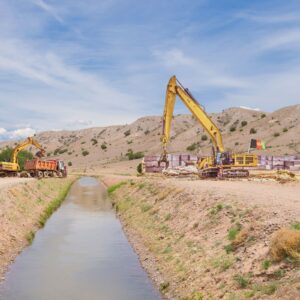Source: The World Bank Group
Written by: Taylor Anderson, Jenna Hershberger, Sarah Jenson, Jake Ledoux, Jesse Puka-Beals, Ryan Sherman
Edited by: Eghosa Asemota and Nida Mahmud
With its limited arable land and high population density, Myanmar must prioritize a methodical response that addresses the intensification of food and land scarcity as well as redresses lagging foreign and domestic investment in agriculture. An analysis of the country’s current agricultural system– namely, its research infrastructure, seed technology, fertilizer use, irrigation strategies, and mechanization– illuminates the need for crucial agricultural upgrades and strengthened cooperative structures that empower smallholder farmers to actualize such upgrades effectively.
Land and Food Scarcity
Myanmar’s future challenges are embedded within the context of the Asian continent. Arable land is a uniquely valuable commodity in Asia. Highly suitable soil for cultivation comprises less than four percent of the land in Asia, far lower than Latin America at twelve percent, or Africa at fifteen percent.[1] The population density of the continent is also higher than any of the other five inhabited continents, creating inherent challenges for food and land scarcity that are particularly stark in Southeast Asia. It is estimated that Southeast Asian farmers will need to produce 1.4 percent more food per hectare every year until 2050 to meet local food demands. Relying on food importation increases the risk of famine and inadequate food availability due to poor infrastructure and large distances between markets. Within the region, Myanmar faces unique challenges supplying food for its population.[2]
Unique to Myanmar among countries in Southeast Asia is a recent history of severe economic isolation due to the government’s strong internal control of market institutions as well as economic sanctions imposed by the United States, Canada, and the European Union. The recent economic liberalization since 2011 has exposed Myanmar to markets in which it is far behind, and to a profusion of technologies which have been designed in context to other countries. Myanmar is therefore faced with the unique problem of attempting to adapt and upgrade all aspects of its agricultural systems at once, a situation that requires a careful and holistic strategy.
Cooperative Structures and Farmer Responsiveness
The structural weaknesses which abound within Southeast Asian agricultural systems such as Myanmar’s are due to lagging foreign and domestic investment. In the twenty-first century, government expenditures on agriculture have decreased from 10.3 percent of the total budget in 2000, to 6.3 percent in 2014[3]. Ba Hein, the Region Minister of Agriculture in Myanmar’s most productive agricultural district, the Ayeyarwady Delta, reported insufficient government funding and investment throughout the region in 2016.[4]
Despite the hardships of urban life, farm families demonstrate near uniform ambition to find alternative incomes to farming. Before the twenty-first century, the average farmer age was increasing and farm sizes were expanding– observations were confirmed upon visiting farm families in Myanmar in 2017.[5] Improving and expanding Myanmar’s agricultural sector requires education and research, the development of improved seed, fertilizer and irrigation infrastructure, and mechanization. However, as the second largest country in Southeast Asia– with climates and geography ranging from the mountains to deltas, deserts, alpine regions, subtropics, and tropics a single agricultural upgrade strategy will not be possible. Any effective approach that seeks to improve Myanmar as a whole must account for these enormous variations.
As crucial agricultural upgrades are discussed, there is a need for a unifying structure to facilitate all these on community levels to ensure responsiveness to farmers’ needs. Myanmar, therefore, requires development structures designed to meet farmers on regional levels, foster their direct involvement, and ensure localized solutions that target constraints unique to the systems they navigate. Strong farmer cooperatives are key to prioritizing the interests of farmers; responding to regional needs; acting as intermediaries among farmers, agencies, corporations, and investors; and enabling access to crucial services, inputs, markets, and producers.[6] This aggregating principle will extend the effectiveness and reach of all agricultural upgrades to facilitate universal benefit.
Upgrading Agricultural Technologies
Research
Modern agricultural research in Myanmar focuses on increasing productivity while enhancing the sustainability of agricultural practices through resource management with an emphasis on making policy recommendations based on research results.[7] Consequently, much of Myanmar’s agricultural research centers on crop improvement trials and variety development. This limited research focus has led to limited research outputs and fewer developments to widespread agricultural management techniques like multi-cropping systems, which would increase the resilience of smallholder farmers more than continued development of a single crop.[8] Limited funding compounds these problems of limited research scope.. The lack of resources and outdated libraries at Yezin Agricultural University (YAU), an institution established in 1924 to train future agricultural scientists, make recent scientific literature inaccessible to research scientists.[9] The lack of direct communication between researchers and farmers also hampers research infrastructure. Extension agents act as messengers instead, communicating research results to farmers and farmer needs to researchers.[10] As part of extension efforts, Contact Farmers (CFs) are assigned to villages, are appointed as leaders, act as the primary contact for extension agents, are responsible for organizing field trials and experimental plots with extension agents, and are responsible for training other farmers in the village.[11] However, since extension agents often lack the project understanding or training needed to implement researchers’ recommendations, there is often low overall adoption of new recommendations.[12]
It is thus vital that the current government prioritize agricultural research and allocate more funding – at least $0.50 per $100.00 agricultural GDP – to federal agricultural research programs. Without this increase, the development of useful research will be severely impaired. When thinking about research for the future, a significant portion of agricultural research needs to be focused on crop productivity and food self-sufficiency. Crop diversification is also needed,[13] as the current funding climate and government prioritization of rice research means that rice is often studied at the expense of other staple crops.[14] The Myanmar government must expand research in the public agricultural sector so that it can focus on topics that are responsive to farmers’ needs. This will require reliable two-way information pathways between farmers and researchers, research institutions interested in rural livelihoods, and the incorporation of farmer advocates into policy conversations. Establishment of cooperatives could facilitate collaboration between researchers, extension agents, and farmers on a regional scale, and could allow local needs to guide research questions.[15]
Seed Production, Quality, and Availability
Understanding the importance of the agricultural economy, the Myanmar government has placed a significant emphasis on improving the agricultural infrastructure and enhancing access to clean, affordable, and high-yielding seed in order to improve agricultural productivity more rapidly. Notably, Myanmar’s parliament recently enacted a suite of laws intended to bolster private sector involvement in seed production through incentives and intellectual property protections. Such laws are a necessary first step for a country transitioning from a centrally planned agricultural system– in which seed and food production, marketing, and trade were coordinated by the central government– to one that encourages private-sector contributions. However, because of both a deficit in investment in the marketing and production of quality certified seed and an infrastructural system that excludes access to small-holder farmers in remote villages, the benefits of these contributions are not universally enjoyed.
Myanmar’s primary crops consist of upland and lowland rice, maize, beans, pulses, and oilseeds. Of these, only maize and some pulses are regularly grown from certified seed and Myanmar farmers usually reuse a portion of their own crop or source seed from neighboring farmers or villages. Smallholder farmers must be included in the evolving seed production system to ensure the proper distribution of economic gains across the agricultural economy as well as close the large gap between supply and projected demand for certified seed. To preserve the role of smallholder farmers in the production of seed, contract farming between these farmers and either Myanmar’s Department of Agriculture (DOA) or private agribusinesses would need to expand. Increased cooperation between the private sector and the DOA to generate registered seed, and increased cooperation between the private sector and small farmers to produce certified seed would benefit the system since the DOA does not have the funds to broadly and unilaterally increase its agreements with farmers. In such a scheme, private businesses would provide registered seed (and potentially farming inputs) to contracted smallholder farmers and would buy back the resulting certified seed which would be cleaned, graded, and packaged for sale the following year. The Myanmar government will need to augment this scheme with amended seed law that explicitly protects certified seed-producing smallholder farmers from abusive contracts, price fluctuations, and quality issues resulting from uncontrollable environmental conditions.
The Department of Agriculture (DOA) should work to boost demand for quality seed through pluralistic extension approaches and marketing campaigns advocating the benefits of certified adapted seed. The establishment of a pilot program linking existing informal seed villages with formal private breeding companies would assist with this. Also, since a current lack of coordination between entities hampers Myanmar’s seed-producing system, the country would benefit from the creation of an entity that leads and manages the transition to a privatized seed industry. The responsibility of this entity would be to encourage a public-private dialogue in the formation of a seed sector transition plan, to coordinate the entry of agribusinesses, NGOs, and international investors into priority challenge sectors. Lastly, since the success of seed research and development depends on pathways that connect farmers to seeds and information, farmer cooperatives will be tasked with coordinating seed demand in remote regions, and reducing inhibitive extension and transport costs for all stakeholders[16] as better seeds become available and Myanmar’s research and development capacities improve.
Fertilizer
In order to reach its full agricultural potential, Myanmar must address issues of quality, market inefficiency, inaccessibility, and lack of education in its fertilizer sector.
Across all channels of fertilizer distribution in Myanmar, there is a severe lack of quality testing at the farmer level.[17] Combined with the large-scale quality issues throughout both domestic and imported fertilizer distribution channels, this poses a significant problem for farmers. The government of Myanmar must establish and outfit laboratories and a testing service to ensure the consistently high quality of products being developed and entering domestic markets. This will not be an insignificant task for a single lab to undertake, but will instead require country-wide coordination and cooperation.
As it stands now, the fertilizer industry in Myanmar is fraught with unclear policy, unnecessary middlemen, and inefficient transportation networks. In order to decrease fertilizer costs for farmers and therefore increase use and agricultural yields, the efficiency of the entire industry must be improved. This begins with increasing domestic production to meet demand. Redirecting a larger portion of the country’s natural gas resources to the two idle government urea factories has the potential to cut the supply deficit, but this must be paired with clear and fair policy implementation in order to increase access to domestic fertilizer for those who need it. Permit acquisition processes must be fair and stated in a straightforward manner. Package labels must be clearly marked with safety and use information for both domestic and imported products. Import registration requirements must be unambiguous and well-enforced. Within-country transportation networks, funded by the government, must also be improved. This will aid in decreasing transportation costs, the savings from which can be passed to the farmer.
Due to unfavorable price ratios since the 1990’s, nitrogen is severely limited in Myanmar’s soils resulting in fertilizer application rates that are far below ideal levels. Increased use of urea alone, however, will not be enough to solve Myanmar’s nitrogen problems. The fertilizer must be managed correctly to maximize nitrogen use efficiency and to minimize environmental impacts. This involves the development of a nutrient management plan with the correct timing and combination of fertilizers, weed control, cultivar selection, irrigation technique and timing, and plant density.[18] Cooperatives will need to provide farmers with access to fair credit. They can protect farmers from unscrupulous lenders and risk. Credit can be used effectively to purchase inputs such as fertilizer prior to harvest, allowing farmers to apply the fertilizer they need to maximize yields and pay back their loans after harvest with more net profit.
Irrigation
Current challenges in water and irrigation include the lack of a unified policy, overlap in formal duties among ten ministries, an overemphasis on rice system irrigation, and dangers related to overexploitation and environmental pollution.[19]
Irrigation projects that are currently being developed in Myanmar in collaboration with other countries and research programs require considerations about their social impact on the community.[20] There is, therefore, a need to prioritize local community empowerment. This will require reforms to water law policy within Myanmar to provide communities more authority in managing their water use and cognizance of environmental costs. Cooperatives have an important role to play in both coordinating management plans that account for local variability and being an advocate for rural people’s interests. For water management plans, however, coordinating interests among users is crucial. Water user associations are a common type of limited cooperative. Myanmar’s rural communities can benefit greatly if water user associations can be expanded to other areas or integrated into a larger cooperative framework. They will enable extension services to disseminate information about new irrigation techniques and technologies. They will facilitate research and development efforts on irrigation system improvements and address shared-resource risk, such as depletion and overexploitation that results when use is uncoordinated.
As Myanmar’s agricultural sector continues to develop, rapidly increasing water demands (up 156 percent since 1990) risk having serious environmental impacts if not effectively managed. Unfortunately, virtually no reports on the development of Myanmar’s agricultural sector seriously discuss the host of environmental consequences that occur from the mismanagement of natural resources. Research conducted at YAU focuses on improving yield and intensifying inputs. Such efforts must be matched with efforts to understand, monitor, and ensure the health of Myanmar’s ecosystems to ensure the longevity and productiveness of Myanmar’s agricultural sector.[21] [22] [23] The government must also establish reliable monitoring services of rivers to ensure the health of its fisheries which are a critical aspect of Myanmar’s economy.
Mechanization
Myanmar was once one of the biggest rice producers in the world, and today it is number six in the world for rice production, with eight million hectares of rice planted on over fifty percent of its arable land.[24] The rise in yield has suffered some stagnation in part due to lower fertilizer application. Even though annual consumption per person went down, rice consumption still increased by sixty percent because of rapid population growth.[25] As the population continues to grow, rice production must become more efficient in regard to time, harvest losses, and inputs. Unfortunately, the lack of capital investment has largely prevented farmers from producing higher yields as, without capital for the initial investments, fertilizers, and farm machinery purchases are both impossible.
To fortify mechanization and increase efficiency, farm equipment must be accessible to farmers. Microfinance lenders can help small shareholder farmers buy less expensive pieces of equipment, such as power tillers, which can have a huge impact on productivity. For larger machines, such as combine harvesters or tractors, group purchasing by local farmers can make a difference in production, improving livelihoods by targeting constraints that limit productivity and increase output past the subsistence level. To ensure the longevity of farm equipment and its proper use, mechanization training about how farmers should use and repair equipment must become more commonplace.
The most practical strategy for effective mechanization will be the creation of information pathways and opportunities that will enable farmer-led adaptation. Farmer cooperatives can facilitate these pathways and coordinate farmers’ needs and interests when learning, upgrading, or repairing farmer technologies. Cooperatives can also aid in mitigating financial obstacles by offering microloans as an effective alternative to private financial institutions and help in the collective purchasing of otherwise inaccessible equipment. The cooperative finance model includes multiple advantages for rural borrowers. First, loans from the cooperative to its members are collectively owned so that a collective social interest pressures members to use money responsibly. Second, transaction costs and profit interests are largely eliminated, making loans much more affordable. Third, as a local institution, cooperatives are not tempted to cut losses and leave, extracting as much value as possible from the system in the process. Finally, a well-developed cooperative will provide the network necessary for governmental and development agencies to offer microfinance services.
Conclusion
Each of these crucial areas (seed technology, fertilizer, research, mechanization, and irrigation) is interdependent and, therefore, must be developed together. Ramping up fertilizer to increase yields without accounting for changes in water needs, for example, is shortsighted. Efforts to deliver new seed technology to rural areas must be supported by effective extension if the new variety requires different management practices. Upgrades in mechanization also require the local capacity for farm equipment maintenance. Like many Southeast Asian countries, the story of Myanmar in the twentieth century was one of exploitation and oppression. Powerful domestic and international political and business entities have the potential to further exploit the Myanmar people, extracting and exporting value from land and labor through coercive arrangements. Governments and/or NGOs need to help strengthen farmer-led rural institutions such as cooperatives to coordinate development efforts; act as intermediaries between farmers, agencies, and business interests; advocate for the interests of rural people, and connect farmers to markets. An aggregated approach that employs the use of farmer cooperatives has the potential to enhance the effectiveness of each agricultural upgrade recommendation and support an overall more equitable, sustainable, and resilient agricultural system.
This case study was made possible through a review of current literature and a three-week field-study visit made possible through IARD 6020: International Agriculture in Developing Nations, a course offered at Cornell University.
References
- Bindu N. Lohani, “Environmental Challenges in Asia in the 21st Century” (Manila: Asian Development Bank, 1998). ↑
- Günther Fischer, Eva Hizsnyik, Sylvia Prieler and David Wiberg, “Scarcity and Abundance of Land Resources: Competing Uses and the Shrinking Land Resource Base,” SOLAW Background Thematic Report – TR02 (2016) http://www.fao.org/fileadmin/templates/solaw/files/thematic_reports/TR_02_light.pdf ↑
- Ibid. ↑
- Myanmar Now, “As Labourers Leave Myanmar Delta, Farmers Struggle to Mechanise,” Myanmar Times (2016), The Myanmar Times, https://www.mmtimes.com/business/24067-as-labourers-leave-myanmar-delta-farmers-struggle-to-mechanise.html ↑
- Hector Malano, Martin Burton, and Ian Makin, “Benchmarking Performance in the Irrigation and Drainage Sector: A Tool for Change,” Irrigation and Drainage 53, no. 2 (2004): , doi:10.1002/ird.126. ↑
- FAO, “Agricultural Cooperatives – Key to Feeding the World,” 2012 World Food Day Celebration Report (2012), Food and Agricultural Organisation ↑
- Tin Hlaing, “Agricultural Research, Extension, and Rural Development in Myanmar,” (2004), Myanmar Academy of Agricultural, Forestry, Livestock, and Fishery Sciences ↑
- Ibid. ↑
- Personal communication, Lei Li; Hlaing et al., Agricultural Research ↑
- Personal communication, Khin Thet Maw ↑
- Hlaing et al., Agricultural Research ↑
- UNDP, “Myanmar Agricultural Sector Review and Investment Strategy Volume 2: Agriculture Sector Investment Strategy” (2004). ↑
- Personal observation; Hlaing et al., Agricultural Research ↑
- Than Tun, Adam Kennedy and Ulrike Nischan, “Promoting Agricultural Growth in Myanmar: A Review of Policies and an Assessment of Knowledge Gaps” (2015) https://mdricesd.files.wordpress.com/2016/01/report-ag-growth-nov-2015.pdf ↑
- Virginia R. Cardenas, Evangeline Sulabo, Rowena Baconguis, Federico A. Cruz, Yolanda Mendoza, Elvira Talatayod, Francisca Tan, and Lorna Domingo, “Community-Based Participatory Extension Management andEmpowerment: Institutionalization and Scaling Up”, Good Practices: Institutional Development (2005) FAO http://www.fao.org/farmingsystems/pdf/IFSA/Good_Practices_Institutional_Development.pdf ↑
- FAO, “Formulation and Operationalization Of A National Action Plan For Poverty Alleviation and Rural Development Through Agriculture (NAPA)”, Lower Mekong Food Security Database (2015) http://foodsecurity.mekonginstitute.org/project-816 ↑
- Paul Roelofsen, Dr. Min Aung and Dr. Khin Hnin Yu, “Report on the Policy Analysis of the Myanmar Seed Law and Seed Policy”, Livelihoods and Food Security Trust Fund (2015) https://www.myanmarfswg.org/sites/myanmarfswg.org/files/seed_policy_analysis_eng.pdf ↑
- Achim Doberman and Thomas Fairhurst, “Rice: Nutrient Disorders & Nutrient Management”, Nutrient Disorders and Nutrient Management (2000), Potash & Phosphate Institute (PPI), Potash & Phosphate Institute of Canada (PPIC) and International Rice Research Institute http://www.ipni.net/ppiweb/filelib.nsf/0/2BB52995AF6F76E248257074002997BC/$file/TOC%20Rice%20HB.pdf ↑
- Than Tun et al., Knowledge Gaps ↑
- Hector Malano, Martin Burton, and Ian Makin, “Benchmarking Performance in the Irrigation and Drainage Sector: A Tool for Change,” Irrigation and Drainage 53, no. 2 (2004): , doi:10.1002/ird.126. ↑
- John P. Reganold, Lloyd F. Elliott, and Yvonne L. Unger, “Long-term Effects of Organic and Conventional Farming on Soil Erosion,” Nature 330, no. 6146 (1987): , doi:10.1038/330370a0. ↑
- Bram Moeskops et al., “Soil Microbial Communities and Activities under Intensive Organic and Conventional Vegetable Farming in West Java, Indonesia,” Applied Soil Ecology 45, no. 2 (2010): , doi:10.1016/j.apsoil.2010.03.005. ↑
- Fritz Oehl et al., “Impact of Long-term Conventional and Organic Farming on the Diversity of Arbuscular Mycorrhizal Fungi,” Oecologia 138, no. 4 (2004): , doi:10.1007/s00442-003-1458-2. ↑
- Ricepedia, Research Program on Rice (2013), IRRI; AfricaRice; CIAT http://ricepedia.org/myanmar ↑
- Ibid. ↑





